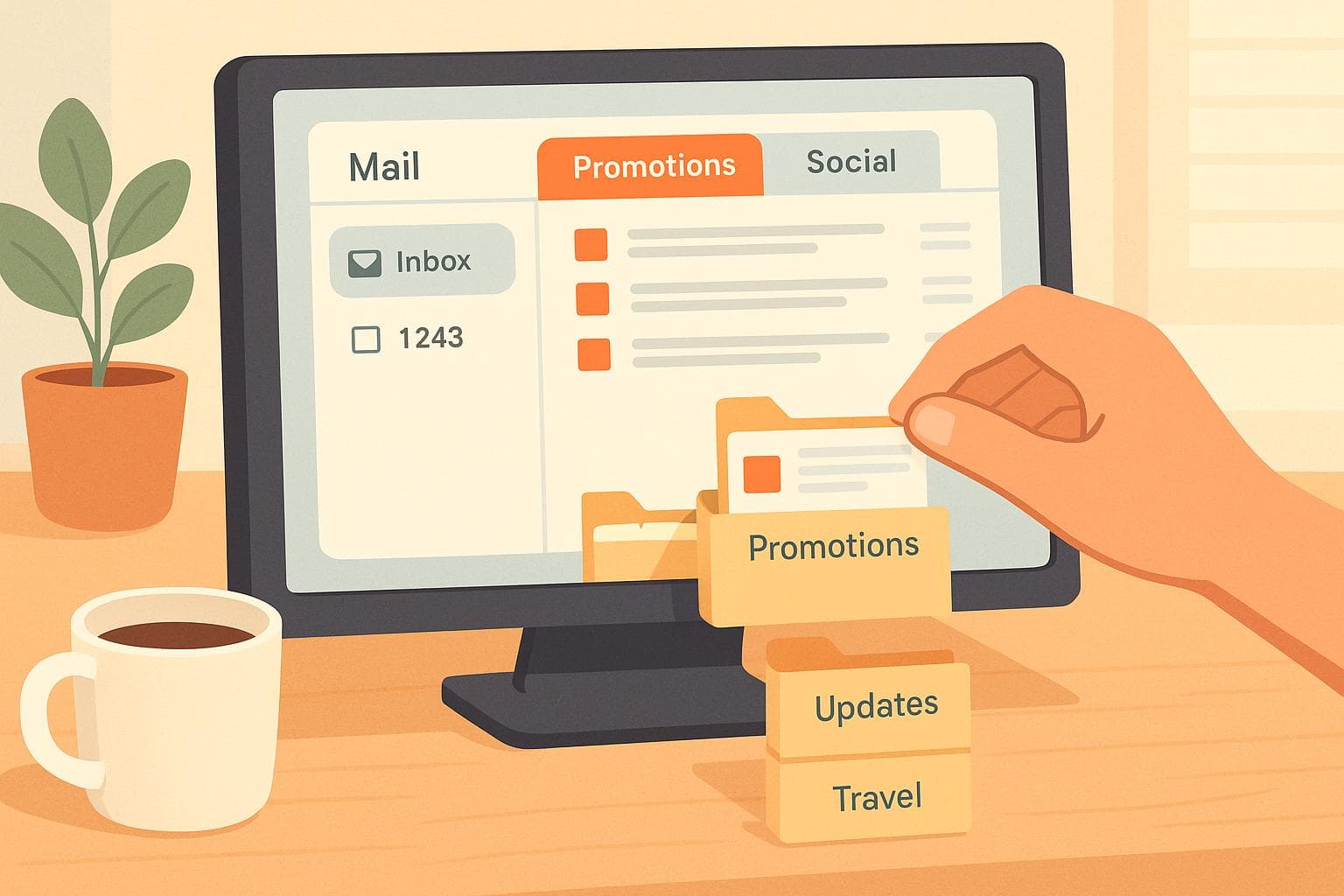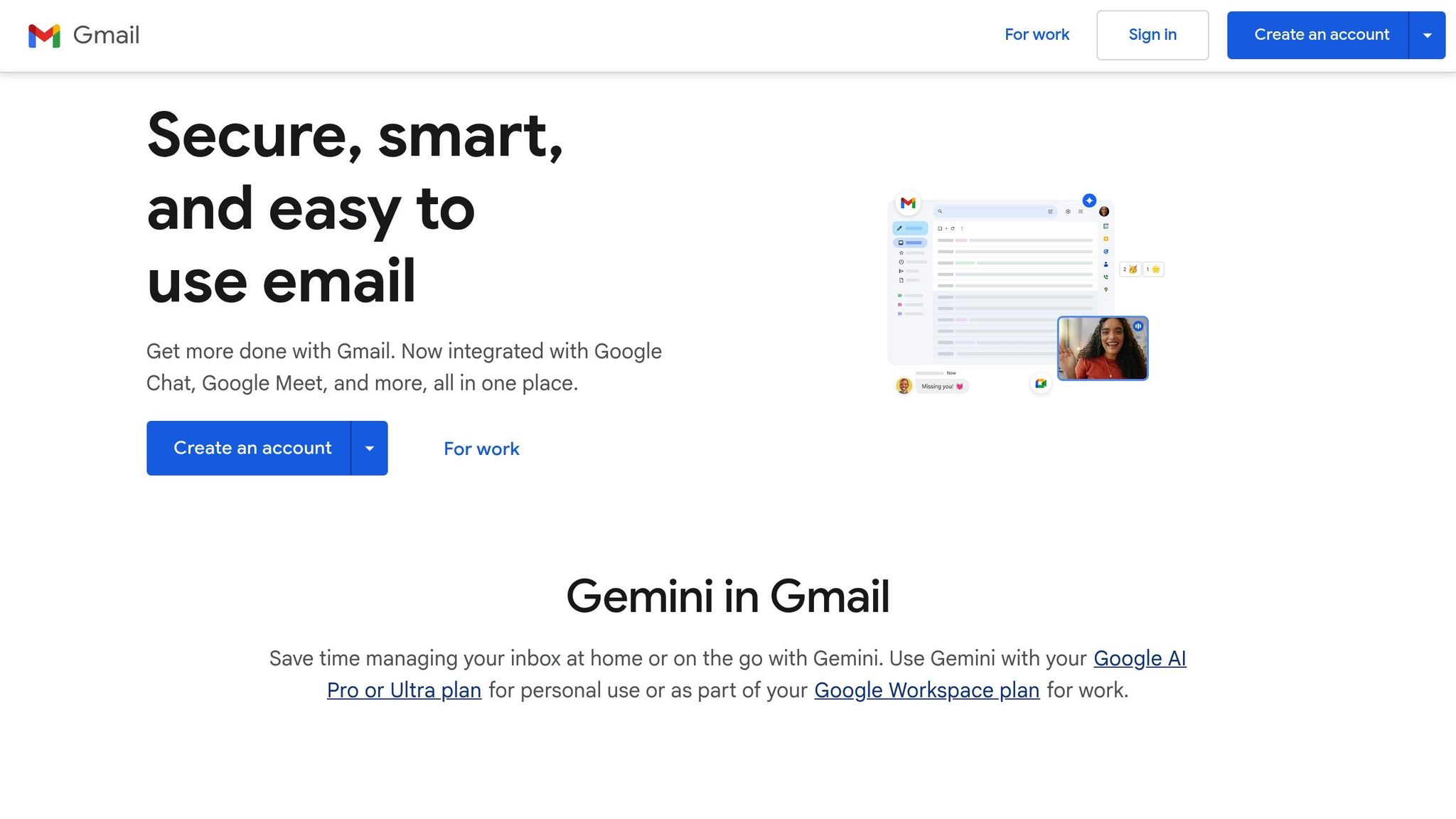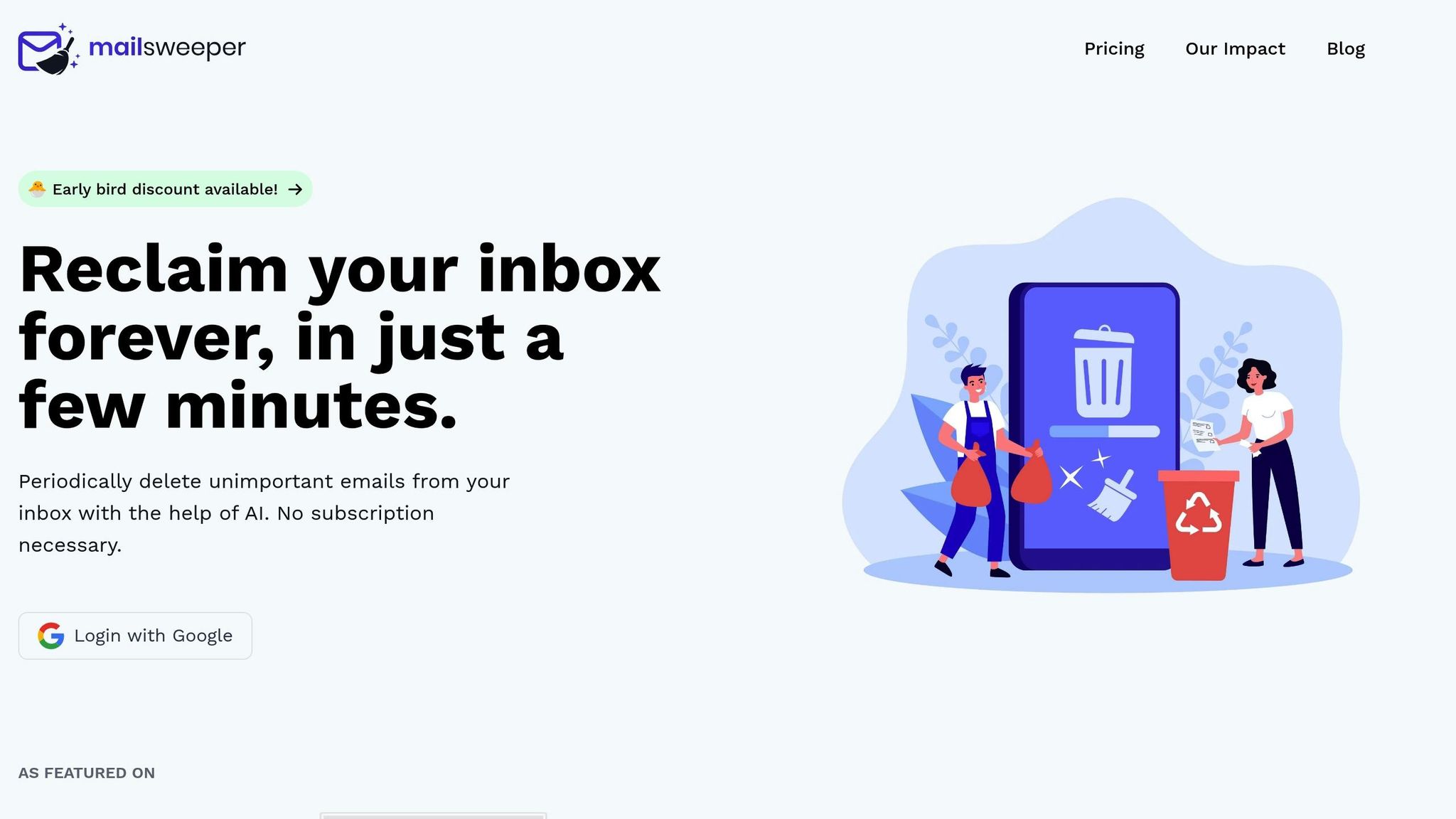Email Management
Ultimate Guide To Managing Gmail Promotions Storage
Learn effective strategies to manage Gmail's promotional emails and free up valuable storage space with simple cleanup techniques.

Ultimate Guide To Managing Gmail Promotions Storage
Managing Gmail storage can feel overwhelming, especially when promotional emails pile up. These emails, often filled with large attachments and images, can quickly eat into your 15 GB free storage limit, which is shared across Gmail, Google Drive, and Google Photos. Hitting this limit can mean paying for extra storage or losing access to new emails. Here's how to handle it:
- Bulk Delete Promotional Emails: Use Gmail's "Select all conversations in Promotions" option to quickly delete large volumes of emails.
- Search Commands: Target storage-heavy emails with commands like
category:promotions larger:10Morcategory:promotions older_than:1y. - Unsubscribe: Avoid future clutter by unsubscribing from emails you no longer read.
- Filters and Labels: Automate sorting and deletion of promotional emails using Gmail filters.
- MailSweeper Tool: Automate inbox cleanup with tools like MailSweeper, which uses AI to identify and delete unnecessary emails, saving time and storage.
How to Clean Up Gmail Storage in 5 Easy Steps

How Gmail Promotions Affect Your Storage
Managing your Gmail storage effectively starts with understanding how promotional emails impact your account. These emails not only clutter your inbox but also eat into the shared storage limit across Gmail, Google Drive, and Google Photos. Let’s break down how Gmail handles these messages and the role they play in your storage usage.
What Is the Gmail Promotions Tab?
The Gmail Promotions tab is a specialized section designed to keep marketing emails out of your Primary inbox. It automatically filters sales offers, newsletters, discount codes, and similar content, helping you focus on personal and work-related messages.
Gmail’s algorithms decide what lands in the Promotions tab by analyzing factors like the sender’s reputation, email content, formatting, and the use of marketing phrases. For example, emails containing terms like "limited time offer" or "exclusive deal" are prime candidates for this tab.
If an important email ends up in Promotions by mistake, you can manually move it to your Primary inbox. Gmail takes note of this adjustment and improves its sorting for future emails. While this system is helpful, it also means promotional emails can pile up unnoticed, quietly consuming your storage.
How Promotional Emails Impact Your Gmail Storage
Promotional emails can quickly eat up storage, thanks to their frequent use of large attachments, high-resolution images, and embedded media. A single promotional email might range from a few kilobytes to several megabytes, depending on its content. For instance, receiving 1,000 emails averaging 1 MB each could use up over 1 GB of your storage. Over time, this adds up substantially, especially when promotional emails account for 20–50% of a typical user’s inbox.
Retailer newsletters with product images, PDF coupons, or attached flyers are particularly storage-heavy. Even emails that look simple at first might contain hidden media or attachments that make them larger than expected. This accumulation of data can significantly impact your storage quota.
Gmail Storage Limits and How They Work
Gmail offers 15 GB of free storage, which is shared across Gmail, Google Drive, and Google Photos. Every email, including those in the Promotions tab, counts toward this limit - attachments and embedded images included. Once you hit this limit, you’ll need to either purchase extra storage or risk missing new emails.
It’s important to know that deleting emails doesn’t immediately free up space. Emails moved to the Trash remain there for 30 days and still count toward your quota during that time. Similarly, archiving emails only removes them from your inbox view; it doesn’t reduce your total storage. The only way to reclaim space is by permanently deleting emails from the Trash.
Promotional emails alone can take up a significant portion of your storage. If these messages account for 30% of your usage, that’s 4–5 GB tied up in marketing emails when you’re nearing the 15 GB limit. For many users, this could mean the difference between staying within the free tier and paying for additional storage.
This highlights why managing promotional emails is more than just decluttering - it’s about preserving valuable storage space and avoiding unnecessary costs. Left unchecked, these emails can quickly become a costly burden.
Ways to Reduce Promotional Email Storage
Promotional emails can quickly eat up your Gmail storage. In fact, 74% of all emails are categorized as Promotions, and 69% of those are never opened. That’s a lot of wasted space! The good news? Clearing out these unnecessary emails is easier than you might think. By following a few simple steps, you can free up gigabytes of space and make your inbox more manageable.
How to Delete Promotional Emails in Bulk
Bulk deletion is one of the fastest ways to clear out storage-hogging promotional emails. Whether you’re using Gmail on desktop or mobile, the process is straightforward and can help you delete thousands of emails in just minutes.
On Desktop and Mobile Gmail:
- Desktop: Open the Promotions tab, click the checkbox at the top-left to select all visible emails, and look for the yellow banner offering to "Select all conversations in Promotions." Click it to select every promotional email in your account, then hit the trash icon.
- Mobile: Go to the Promotions tab, press and hold an email to activate selection mode, then either tap additional emails manually or select all. Once done, tap the trash icon.
Deleted emails are moved to the Trash folder, where they’ll stay for 30 days before being permanently removed. This gives you time to recover anything you might delete by mistake. Many users report freeing up over 2 GB of storage simply by deleting years of promotional emails, particularly those with large attachments like newsletters and sales offers.
Archive vs Delete: Which Saves More Storage?
One common question is whether to archive or delete promotional emails. Here’s the deal: Archiving doesn’t save any storage space. It just moves emails out of your inbox view and into the "All Mail" folder, where they still count toward your 15 GB storage limit. Only deleting emails will actually free up space.
Here’s a quick comparison:
| Option | Storage Impact | Best For | Drawbacks |
|---|---|---|---|
| Delete | Frees storage after 30 days | Maximizing storage savings | Emails are permanently removed after 30 days |
| Archive | No storage savings | Keeping searchable records | Emails still take up storage space |
Given that most promotional emails lose relevance quickly - think outdated sales or old newsletters - deleting them is usually the smarter choice.
Gmail Search Commands for Finding Large Emails
If you want to target the biggest space offenders, Gmail’s search commands can help you locate and delete large promotional emails. This is especially useful for finding emails with big attachments or oversized files.
Try these search commands:
category:promotions larger:10M
Finds promotional emails larger than 10 MB.category:promotions has:attachment
Locates promotional emails with attachments.category:promotions larger:5M
Targets emails over 5 MB (you can adjust the size as needed).
Promotional emails often come with large attachments like product catalogs, PDF coupons, or flashy marketing images. These can easily take up 10–20 MB per email, quickly adding up over time.
Once you’ve run a search, follow the bulk deletion steps outlined earlier. Start with the largest files (larger:10M) and work your way down to smaller sizes.
Pro tip: Use the command category:promotions older_than:1y to find promotional emails older than a year. These are usually safe to delete since they’re unlikely to contain anything you still need.
sbb-itb-34b9fd2
Stop Future Promotional Email Buildup
Keeping your Gmail storage in check means stopping promotional emails from piling up in the first place. While clearing out existing clutter is helpful, taking steps to prevent future buildup saves you from constantly battling a messy inbox.
How to Unsubscribe from Unwanted Emails
Gmail makes it simple to unsubscribe from emails you no longer want. Most promotional messages include an "Unsubscribe" link right at the top, next to the sender's name. This feature lets you opt out directly within Gmail, avoiding the need to click on external links that might not be secure.
- Using Gmail's Built-in Unsubscribe: When you see the "Unsubscribe" link at the top of an email, click it. Gmail will take care of the rest, and you'll stop receiving emails from that sender within a few days. This works well for legitimate businesses and newsletters.
- Manual Unsubscribing: If Gmail's unsubscribe option isn’t available, scroll to the bottom of the email. Most legitimate companies include an unsubscribe link there, as required by law. Follow the provided steps to remove yourself from their mailing list.
- When to Be Careful: Avoid unsubscribing from emails that look suspicious or spammy. Clicking "unsubscribe" on these can actually confirm your email address is active, which might lead to more spam. Instead, mark these emails as spam and let Gmail’s filters handle them.
Create Filters and Labels for Auto-Management
Gmail’s filters are like having a personal assistant for your inbox. They automatically sort and manage emails based on rules you set, saving you from constant manual cleanup.
-
Setting Up Promotional Filters: Go to Settings > Filters and Blocked Addresses > Create a new filter. Here are a couple of examples you can try:
- Filter for large promotional emails:
category:promotions has:attachment larger:5M→ Action: Delete them. - Filter for old promotional emails:
category:promotions older_than:30d→ Action: Delete them.
- Filter for large promotional emails:
- Keep Filters Updated: Review your filters every few months to make sure they still align with your email habits. If you sign up for new services or your preferences change, tweak or add filters as needed.
Filters and labels are powerful tools for keeping your inbox organized and clutter-free.
Gmail Plus Addressing for Better Email Control
Gmail Plus Addressing is a clever way to manage your inbox without creating multiple email accounts. By adding a "+" and a keyword to your email address, you can track where promotional emails are coming from and organize them more effectively.
-
How It Works: Let’s say your email is johnsmith@gmail.com. You can use variations like:
- johnsmith+shopping@gmail.com for retail sites
- johnsmith+newsletters@gmail.com for subscriptions
- johnsmith+deals@gmail.com for coupon offers
- Creating Filters for Plus Addresses: Once you start using plus addresses, set up filters to manage them. For example, emails sent to "johnsmith+shopping@gmail.com" can be automatically labeled as "Shopping Emails" and archived, keeping your primary inbox tidy while still saving the emails for later reference.
- Spotting Email Sharing: Plus addressing can also reveal if a company has shared your email with third parties. If you receive unexpected emails at a specific plus address, you’ll know your information may have been passed along.
- Dealing with Overwhelmed Plus Addresses: If one of your plus addresses starts getting too much spam, create a filter to automatically delete all emails sent to that address.
Gmail Plus Addressing gives you precise control over promotional emails from the moment you sign up for a service, helping you stay ahead of inbox clutter.
Automate Gmail Cleanup with MailSweeper

Sorting through emails manually can feel like a never-ending chore. That’s where automation comes in handy. MailSweeper steps in to handle the heavy lifting, using artificial intelligence to clear out promotional emails and free up Gmail storage effortlessly. It’s a perfect partner to manual cleanup methods, ensuring your inbox stays organized without constant attention.
What is MailSweeper?
MailSweeper is an AI-driven tool designed to clear out unwanted promotional emails from your Gmail account. Here’s how it works: it securely connects to your Google account, scans your inbox, and moves unnecessary emails to a labeled folder called "Dustpan." From there, those emails can be sent to the trash. Importantly, MailSweeper is programmed to leave your starred emails, important messages, and primary inbox untouched. You also get to decide which email categories it targets, so you remain in control of what stays and what goes.
The results speak for themselves. So far, MailSweeper has processed over 2.7 million emails, saving a whopping 195 GB of storage and reducing carbon emissions by 88.87 kgCO2e. These numbers show just how much space those ignored promotional emails can eat up over time.
MailSweeper Features and Setup
Getting started with MailSweeper is simple and quick. Here’s how to set it up:
- Sign In: Use your Google account to log in and make a one-time purchase. No subscriptions, just a single payment.
- Set Preferences: Answer a few quick questions to guide the AI. You can choose which types of emails to delete, set retention periods, and even create exceptions for specific senders.
- Automatic Cleanup: Once configured, MailSweeper gets to work. It scans your inbox, moves unwanted emails to the "Dustpan" label, and deletes them as per your settings. If you want to keep an email, just remove the Dustpan label - it’s that easy.
Here’s the pricing for users in the U.S.:
| Plan | Price | Availability |
|---|---|---|
| Early Bird | $16 | Limited – 3 left |
| Personal | $20 | Available |
This one-time payment is a budget-friendly alternative to Google One’s $1.99/month fee for an additional 100 GB of storage.
How MailSweeper Saves Storage and Time
Once set up, MailSweeper works quietly in the background, saving both storage space and time. Many users reclaim gigabytes of storage, avoiding the need to upgrade their Gmail plan. Plus, the hours you’d normally spend sorting through promotional emails? MailSweeper gives that time back to you.
For those who receive hundreds of promotional emails each week, this automation is a game-changer. It ensures your Gmail account stays below the 15 GB storage limit, so you never have to worry about missing important new emails. Whether you’re a busy professional, a small business owner, or just someone drowning in email clutter, MailSweeper offers a smart, hands-off solution to keep your inbox manageable and your storage optimized.
Final Tips for Gmail Storage Management
Keeping your Gmail storage in check doesn’t have to feel like a chore. The trick lies in developing simple, consistent habits that stop storage issues before they start. For example, set a monthly reminder to review your Gmail storage via the Google One dashboard. This quick check helps you stay under the 15 GB limit and avoid surprise fees. With these habits in place, you can focus on smart cleanup strategies to keep your inbox running smoothly.
Deleting promotional emails is more effective than archiving them. When you archive emails, they still take up space. Instead, delete promotional emails you don’t need. Just remember, emails in the Trash folder will stay there for 30 days before being permanently removed - so don’t forget to clear it out if you need immediate space.
Preventing clutter is easier than cleaning it up. Unsubscribe from newsletters you no longer read, or use Gmail Plus Addressing to filter incoming mail more effectively. If you need to tackle larger files, Gmail’s search commands can quickly pinpoint bulky attachments or emails clogging up your storage.
For a hands-off approach, consider using an automation tool like MailSweeper. These tools can handle routine inbox cleaning, saving you time while keeping your storage optimized. Pairing automation with occasional manual reviews ensures your inbox stays tidy without much effort.
A little consistency goes a long way. Even spending just 10 minutes each month deleting promotional emails and tidying up can make a big difference. It’s far more effective than waiting for months and then trying to tackle a massive cleanup all at once. Small, regular actions not only save storage but also create an inbox that works better for you.
FAQs
How can MailSweeper help reduce Gmail storage used by promotional emails?
MailSweeper simplifies managing Gmail's promotional emails by automatically detecting and deleting those you don’t need. This not only clears up valuable storage space but also reduces costs and keeps your inbox tidy - all without the hassle of constant manual cleanup.
By routinely removing less important messages, MailSweeper helps you stay within Gmail's free storage limits, minimizes digital clutter, and saves you precious time.
How can Gmail Plus Addressing help organize promotional emails?
Gmail Plus Addressing is a handy feature that can make managing your promotional emails a breeze. Here's how it works: by inserting a plus sign (+) and a keyword into your email address (e.g., yourname+promotions@gmail.com), you create a customized version of your address. This tweak lets you easily sort and organize incoming emails.
When paired with Gmail's filtering tools, this method becomes even more useful. You can automatically label, archive, or even delete emails sent to these modified addresses. It’s a simple way to keep your inbox tidy, save time, and avoid unnecessary clutter.
How can I make sure important emails aren’t accidentally deleted when cleaning up my Gmail inbox?
To make sure important emails don’t accidentally get deleted during bulk cleanups, start by removing any labels or tags from emails you want to keep. This way, they won’t be grouped into automated or bulk deletion actions. Also, take a moment to carefully review your selections before hitting delete to avoid losing anything crucial.
